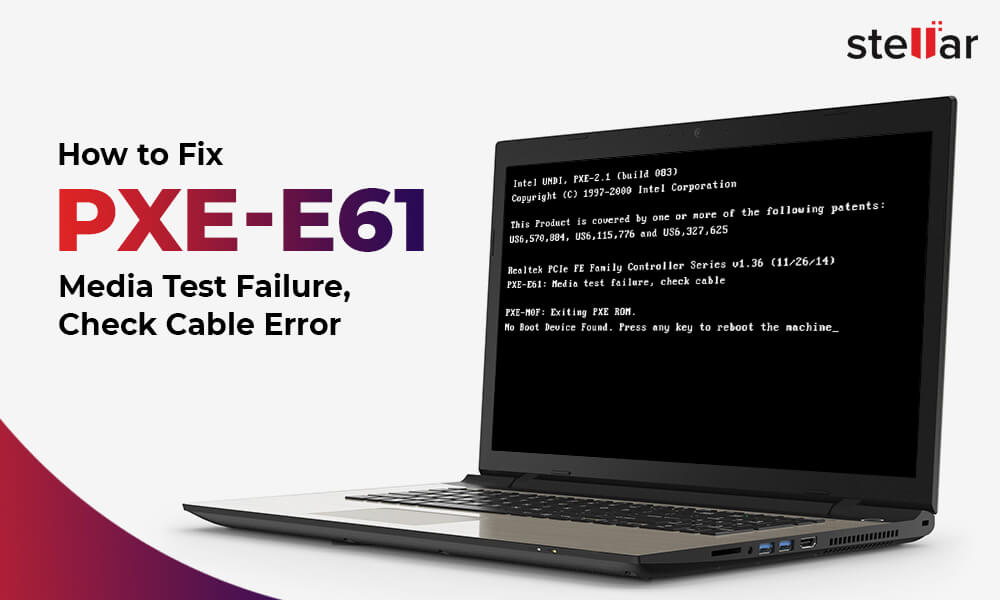PXE-E61: Media Test Failure, Check Cable Boot Error?
This error means that your BIOS settings are incorrect or that your hard disc is failing. It’s critical to understand the underlying cause of PXE-E61 in order to resolve the Media Test Failure, Check Cable issue.
PXE stands for Preboot Execution Environment, and it’s a boot mode that some motherboards support. The machine may now boot from a network disc. Because the computer cannot really detect the boot disc, the entire error message instructs you to examine the cable.
This error might be caused by one of the following factors:
- Power issue
- Damaged ethernet cable
- The misconfigured boot order in BIOS
- Hard drive or network drive is physically damaged, corrupt, or crashed
- Damaged boot sector
We’ll look at how to solve the PXE-E61 Media Test Failure issue in this post. However, if you want to do so, you must always consider calling a Professional Data Recovery Service provider. Attempting to correct the issue on your own may result in irreversible data loss.
How to fix PXE-E61 Media Test Failure, Check Cable Error?

-
Verify the power supply and cables :
The system tries to reboot from the configured bootable network drive as soon as you switch on your computer. The system may not be able to boot due to a faulty or loose connectivity between the hardware, resulting in the PXE-E61: Media Test Failure issue. Examine your network drive thoroughly to ensure that the power connections are correctly connected and not broken. Visit Bravo Electro to learn more about dc and ac power supplies.
-
Remove external USB storage devices:
The BIOS will attempt to boot from USB first because the BIOS is misconfigured and the USB booting has the greatest priority in the boot process. If the attached USB device is indeed not bootable, it will search the network for a bootable device, and you may receive a Media Test Failure error. To avoid booting from USB, remove the external USB device.
-
Replace the damaged hard drive :
If your hard disks are entirely destroyed, you will need to purchase a new one to replace it. You may look for an installation manual online and replace the hard disc on your own.
If you’re not confident in your abilities, you can request a hard drive replacement from the manufacturer or seek expert assistance.
-
Change the boot order in BIOS:
If you wish to boot from either a network drive, make sure the network drive is first in the boot order. If it isn’t already there, move it to the top of the BIOS settings. You may accomplish it in the following way:
- Assign the following commands to the BIOS setup utility:
- Restart or turn on the computer.
- While the computer is turning on, press the key that was used to enter the BIOS setup programme.
- The F2 key is generally used for this (see the manufacturer’s handbook).
- You may modify the boot order by going to the Boot menu.
- Set a network drive as the top importance to boot from using the keys listed on the menu. The device at the very top of the device row gets the greatest priority for booting.
-
Disconnect the network drive or Reset BIOS:
It’s conceivable that you have Operating system on your hard drive, but the attached network drive, which doesn’t contain Windows, is assigned to the upmost importance in the boot process. When the computer tries to start from the network disc, it may fail, resulting in a PXE-E61 error.
Disable the network drive by disconnecting the network cable to repair the PXE-E61 Media Test Failure, Check Cable problem. Alternately, you can restore the BIOS to its default configuration. The device will now boot from the internal hard disc.
Also Read: https://techypot.com/how-to-delete-or-transfer-discord-server/
-
Get the help of Data Recovery Experts:
If none of the options worked, you shouldn’t go to the next step at random. To avoid any data loss, you should contact a Professional Data Recovery Service provider. At the finish of the day, the data is what matters most.
Make regular backups of your computer data:
You can see that computer problems usually occur at the most inconvenient times. To keep your computer data safe, make it a practise to back up your information on a regular basis.
MiniTool ShadowMaker is a professional data backup programme that you may use for computer data backup. The Windows operating system, files/folders, partitions, and the entire drive may all be backed up using this programme. Automated backup, full back up, incremental backup, and differential backup are also supported.
Also Read: gc invoker utility
Conclusion:
After reading this post, you should be able to use several techniques to resolve the PXE-E61 Media test failure check cable issue. You can always find an appropriate solution here, whether you use DELL, Acer, HP, Lenovo, or another brand of system.
If you have any doubts about how to repair this problem or how to use our programme, please leave a comment. You can also contact us with your ideas.
